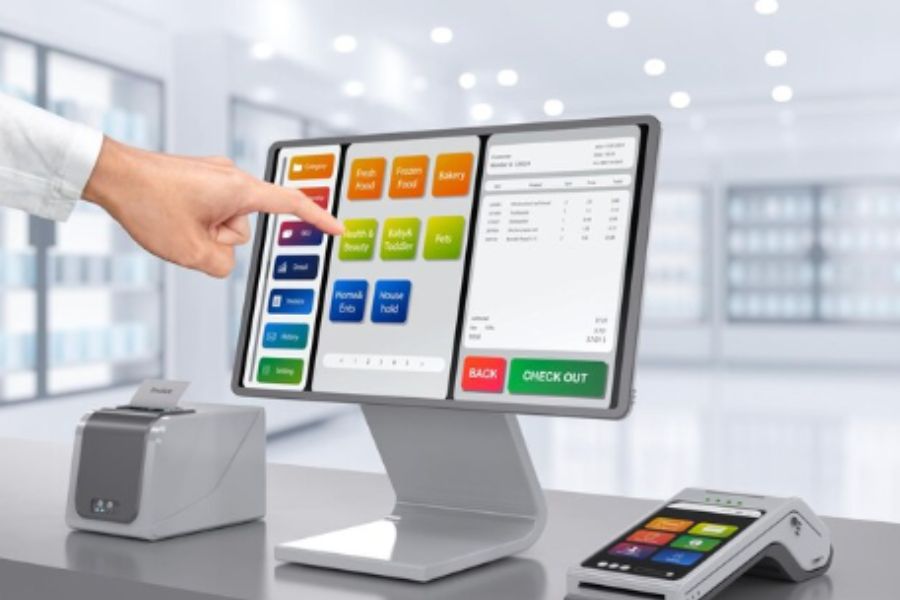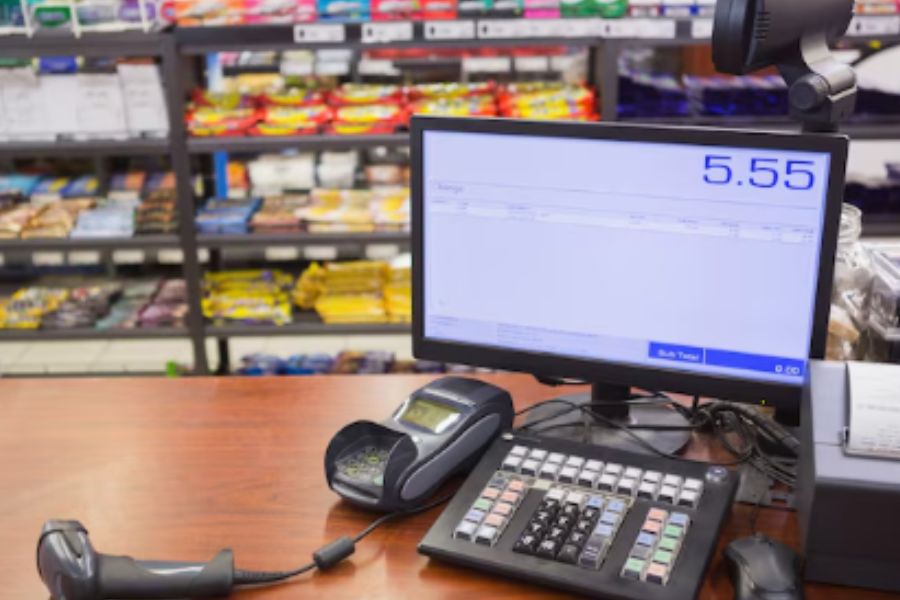In the rapidly evolving landscape of supermarket management, a cutting-edge point-of-sale (POS) system has become indispensable. As technology advances, so do the expectations for features that drive efficiency and enhance customer experiences. This article explores the essential aspects of a 2024 supermarket point of sale. Delving into the must-have features ensures supermarkets have the tools necessary to thrive in a competitive market.
Significance of an efficient point-of-sale system in supermarkets
A POS system represents the fusion of hardware and software intricately crafted to execute transactions, track sales, and supervise diverse business operations in real time. Comprising essential components like a cash register, barcode scanner, receipt printer, and specialized POS software, it serves as the cornerstone of contemporary supermarket management.
In the dynamic landscape of supermarket management, the challenges faced by these retail giants are multifaceted. Supermarkets contend with complexities such as high transaction volumes, diverse product ranges, and the need for seamless customer interactions. Introducing an efficient point-of-sale (POS) system becomes imperative to address these challenges comprehensively.
A supermarket point of sale acts as the nerve center of retail operations, tackling the intricacies of modern supermarkets head-on. The significance of an efficient POS system in supermarkets lies in its ability to streamline processes, enhance customer experiences, and provide invaluable insights for strategic decision-making.
The consolidated features of a supermarket POS system collectively alleviate the common pain points encountered in the supermarket environment. The challenges of managing vast inventories and ensuring accurate stock levels are met with robust inventory management features, preventing overstocking or stockouts. The streamlined checkout process facilitated by intuitive interfaces and quick payment processing addresses the need for transaction efficiency, reducing waiting times for customers.
Must-have features for a 2024 supermarket point of sale system
Streamlined checkout process
In the dynamic landscape of supermarket operations, a streamlined checkout process is a paramount feature for a point-of-sale (POS) system. The efficiency of the checkout process significantly impacts customer satisfaction and operational effectiveness. The 2024 supermarket POS system must encompass features that accelerate transaction processing, ensuring shoppers a swift and hassle-free experience. Key elements of a streamlined checkout process include:
- Fast transaction processing: The POS system should facilitate quick scanning of items, instant calculation of the total amount, and prompt payment processing. This minimizes waiting times for customers and contributes to a positive shopping experience.
- Intuitive user interface: An intuitive and user-friendly interface is crucial for cashiers to navigate the system effortlessly. Clear displays, easy access to essential functions, and minimal steps for transaction completion enhance overall operational speed.
- Support for multiple payment options: To cater to diverse customer preferences, the POS system should seamlessly integrate with various payment methods, including credit/debit cards, mobile payments, and cash. This flexibility ensures convenience for shoppers.
- Integration with loyalty programs: Streamlining the checkout process involves integrating loyalty programs directly into the POS system. This allows customers to redeem rewards, discounts, and promotions seamlessly during the transaction, fostering loyalty and engagement.
Investing in a supermarket POS system with a streamlined checkout process not only enhances the overall shopping experience but also contributes to operational efficiency and customer satisfaction. This essential feature aligns with the evolving demands of the retail landscape in 2024.
Robust inventory management
The year 2024 calls for supermarket POS systems to incorporate robust inventory management capabilities to streamline operations and enhance overall efficiency:
- Automated stock tracking: A cutting-edge POS system for supermarkets in 2024 must provide automated stock tracking features. This ensures that every transaction, whether a sale or restocking activity, is instantly reflected in the inventory database.
- Real-time inventory updates: The ability to receive real-time updates on inventory levels is paramount. This feature enables supermarket managers to make informed decisions promptly, preventing stockouts or overstocking scenarios.
- Multi-location inventory control: Supermarkets often operate across multiple locations. The POS system should empower businesses to manage inventory seamlessly across various branches, ensuring a synchronized and cohesive approach to stock control.
- Alerts and notifications: An advanced POS system should include alert mechanisms for low-stock situations, impending product expirations, or any irregularities in the inventory. These proactive notifications help prevent disruptions in supply chains.
- Integration with suppliers: To further optimize inventory management, a supermarket POS system should support integration with supplier systems. This integration allows for efficient communication regarding restocking needs, order processing, and delivery schedules.
- Historical sales data analysis: Leveraging historical sales data is crucial for supermarkets to forecast demand accurately. The POS system should provide tools for analyzing past sales trends, identifying popular products, and anticipating future inventory requirements.
Enhanced customer experience
In the rapidly evolving landscape of supermarket operations, prioritizing an enhanced customer experience is imperative. A 2024 supermarket point-of-sale (POS) system must encompass features that not only streamline transactions but also elevate the overall shopping journey for customers to ensure an enhanced customer experience:
- Personalized interactions through POS tickets: The POS system should have the capability to recognize and acknowledge loyal customers, providing a personalized touch. Integration with customer data allows for personalized promotions and discounts based on individual preferences and purchase history.
- Efficiency in payment handling: Offering a variety of payment methods, including contactless, mobile payments, and traditional card transactions, caters to diverse customer preferences. Robust security measures ensure the safety of customer payment information, fostering trust and confidence.
- Reduction of queues and wait times: The POS system should support multiple checkout points, distributing customer traffic and minimizing queues. Self-service options of self-service kiosks or express lanes provide customers with alternative, faster checkout solutions.
- Integration with loyalty programs: Seamless loyalty redemption with loyalty programs should enable customers to seamlessly redeem rewards and discounts during the checkout process. Clear communication of loyalty point accumulation ensures customers are aware of and motivated by the benefits.
- Enhanced customer support: In-app assistance of customer support features within the POS system, such as in-app chat or assistance, enhances the overall customer support experience. Query resolution quick resolution of customer queries related to products, pricing, or promotions contributes to a positive shopping experience.
Integration with e-commerce platforms
The integration of point of sale (POS) systems with e-commerce platforms has emerged as a pivotal feature for ensuring seamless and efficient operations. Here’s why this integration stands out as a must-have for supermarkets in 2024:
- Unified retail experience: Integration with e-commerce platforms enables supermarkets to provide a unified retail experience. Customers can seamlessly transition between online and in-store purchases, enjoying a consistent and cohesive shopping journey.
- Multi-channel sales management: Supermarkets can capitalize on multiple sales channels by integrating their POS system with e-commerce platforms. Whether customers choose to shop in-store or online, the POS system ensures a harmonized approach to sales management.
- Efficient order processing: E-commerce integration streamlines the order processing workflow. Orders placed online are seamlessly incorporated into the POS system, enabling efficient order fulfillment and reducing the chances of errors in processing.
- Customer data consistency: The integration ensures consistency in customer data across all channels. Whether a customer makes a purchase in-store or online, the POS system maintains a unified customer profile, facilitating personalized services and targeted marketing strategies.
- Real-time updates: Supermarkets can stay agile and responsive to market changes with real-time updates on product availability and pricing. The integration allows instant modifications, ensuring that customers are informed and the business adapts swiftly.
Advanced reporting and analytics
For supermarket point-of-sale systems to stand out, must incorporate advanced reporting and analytics capabilities, revolutionizing how supermarkets gather, analyze, and leverage data. Here are the essential features that make reporting and analytics a must-have in the POS system:
- Real-time data insights: Empowering supermarkets with real-time data accessibility, enabling quick decision-making. Tracking and analyzing sales data on the fly, helping identify trends, popular products, and peak hours.
- Customizable reports: Allowing supermarkets to customize reports based on specific metrics, facilitating a more focused analysis. Providing a holistic view of various aspects, from sales trends to inventory turnover, in a format tailored to the supermarket’s needs.
- Inventory optimization: Offering insights into inventory levels, allowing supermarkets to optimize stock, prevent overstocking or stockouts, and enhance overall inventory management. Identifying seasonal trends and adjusting inventory accordingly to meet customer demands efficiently.
- Employee performance metrics: Efficient workforce management tracking employee performance metrics, aiding in evaluating productivity, identifying areas for improvement, and streamlining workforce management. Correlating sales data with employee performance to acknowledge top performers and implement targeted training where needed.
- Customer behavior analysis: Analyzing customer behavior data to create personalized marketing strategies, loyalty programs, and promotions. Understanding customer preferences, purchasing patterns, and preferences for a tailored shopping experience.
- Forecasting and trend analysis: utilizing historical data for accurate forecasting, enabling supermarkets to anticipate market trends and plan future strategies. Making informed decisions based on trend analysis, ensuring supermarkets stay ahead in a dynamic retail landscape.
Selecting the right supermarket point-of-sale system
Choosing the ideal point-of-sale (POS) system for your supermarket is a pivotal decision that can significantly impact efficiency, customer experience, and overall business success. In the quest for the perfect POS solution, careful consideration of various factors is paramount. Here, we delve into two crucial considerations: scalability and technical support and training.
Consideration factors:
- Business growth readiness: evaluate the scalability of the POS system to ensure it aligns with your supermarket’s growth trajectory. A system that can seamlessly adapt to the evolving needs of a growing business is essential. Consider how easily the POS system accommodates the addition of new functionalities, locations, or features. Flexibility is key in ensuring that the system remains robust as your supermarket expands.
- Comprehensive support: prioritize a POS system that offers comprehensive technical support. This includes timely assistance for troubleshooting, software updates, and addressing any system-related issues that may arise during operation. Assess the availability and effectiveness of training programs provided by the POS system provider. A well-structured training program ensures that your supermarket staff can efficiently operate the system, maximizing its capabilities.
- ConnectPOS advantage: ConnectPOS emerges as a noteworthy POS solution. Scalability is inherent, providing supermarkets with the ability to scale operations effortlessly. Additionally, ConnectPOS offers robust technical support and comprehensive training programs, ensuring supermarkets get the most out of their POS system investment.
Selecting the right supermarket POS system involves a strategic balance between current operational requirements and future scalability. With considerations like scalability and robust support and training, the chosen POS system becomes an invaluable asset in driving the success of your supermarket. ConnectPOS stands out as a reliable partner in this journey, offering a solution designed to evolve with your supermarket’s needs.
Frequently asked questions (FAQs) about supermarket point of sale systems
Why is a robust point-of-sale system crucial for supermarkets?
A robust POS system is vital for supermarkets due to its central role in managing transactions, inventory, and overall operations. It streamlines the checkout process, enhances efficiency, and provides real-time insights critical for effective decision-making.
Can a supermarket POS system integrate with other business solutions?
Yes, modern supermarket POS systems, including ConnectPOS, offer integration capabilities. They seamlessly integrate with other business solutions like accounting, marketing, and customer relationship management (CRM) systems, creating a unified ecosystem for optimized operations.
What role does customer engagement play in a supermarket POS system?
Customer engagement is pivotal in a supermarket POS system. It contributes to an improved shopping experience through features like personalized promotions, loyalty programs, and quick checkout processes. Positive customer engagement leads to increased satisfaction and loyalty.
What security measures should a supermarket consider when choosing a POS system?
Security is paramount in selecting a POS system. Supermarkets should prioritize encrypted payment processing, secure customer data handling, and adherence to industry standards. Regular system updates and compliance with security regulations are crucial for safeguarding sensitive information.
How can a supermarket transition to a new POS system seamlessly?
A seamless transition involves careful planning, employee training, and effective communication. Prioritize selecting a POS system, like ConnectPOS, that offers comprehensive training programs and robust technical support. Plan the transition during periods of lower business activity to minimize disruptions. Engage employees in the process to ensure a smooth adaptation to the new system.
Conclusion
Embracing the 5 must-have features for your 2024 supermarket point of sale is pivotal for staying ahead in the retail arena. From streamlined checkouts to advanced analytics, these features empower supermarkets to elevate operations and meet evolving customer demands. For a personalized consultation and to explore the ideal POS solution for your supermarket, contact us. Your seamless retail experience begins here.



